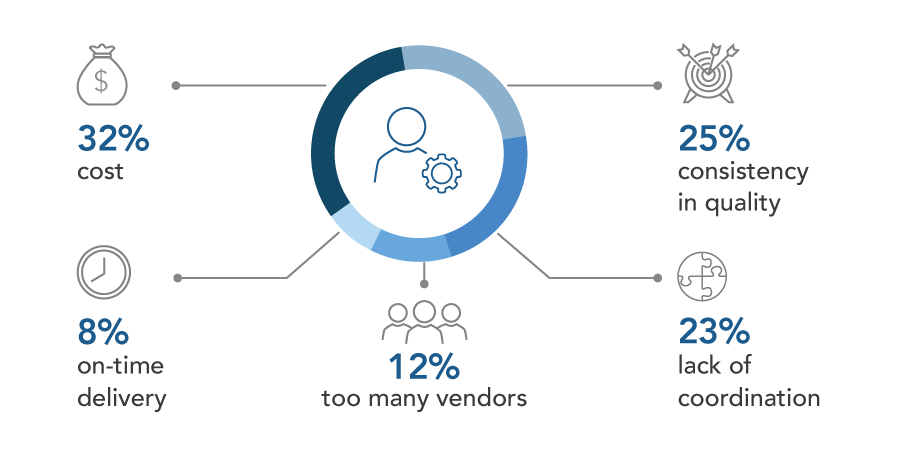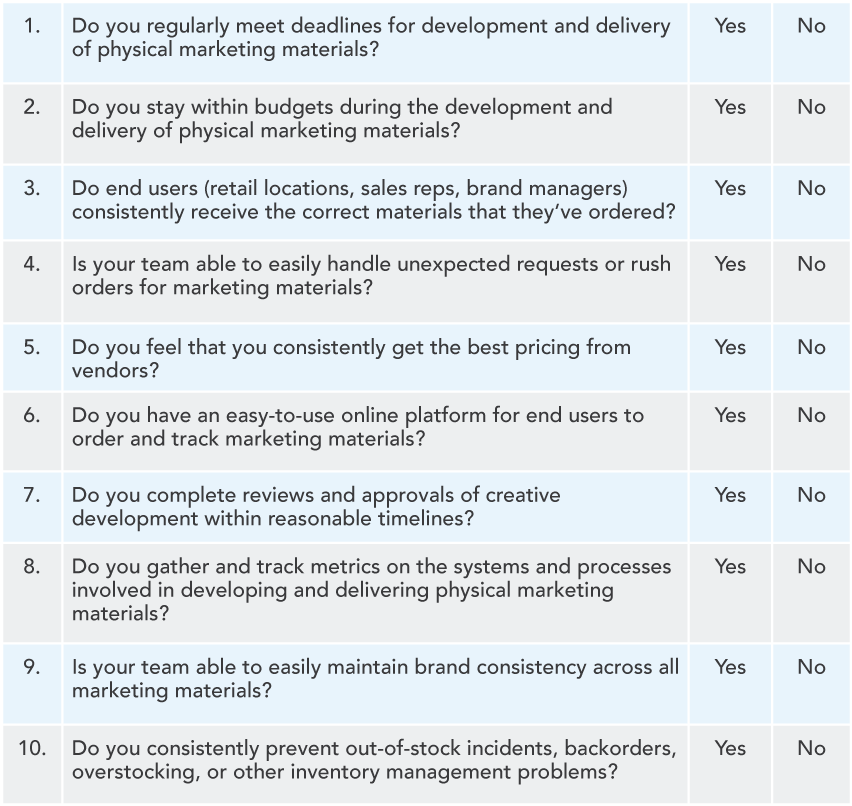4 Steps to More Efficient
Bridging The Gap Between Production and Fulfillment of
Physical Marketing Materials

4 Steps to More Efficient Marketing Execution
Bridging The Gap Between Production and Fulfillment of
Physical Marketing Materials
When it comes to executing physical marketing materials, the processes tend to be similar across companies, regardless of industry. This means the challenges tend to be similar as well. To gain deeper insight into these similarities, NVISION partnered with Canam Research to conduct an industry survey focused on identifying the biggest challenges in managing marketing execution processes, vendors, and costs.
Key insights include:

41% of respondents said they deliver materials on-time, but experience issues with unexpected costs.

29% of respondents stated that “internal resources (hours their people spend)” consume the biggest portion of their physical marketing materials budget.

21% of respondents said that “time” is a primary challenge in meeting their marketing execution goals and responsibilities.
The above challenges largely stem from resource allocation and management—a crucial factor in meeting marketing execution goals. Many companies simply absorb the cost of inherent inefficiencies in their marketing operations. However, those costs over time can create a significant line item expense for marketing departments. Rethinking the processes driving your marketing execution, applying supply chain best practices, and utilizing technology platforms will help capture time efficiencies and cost savings that could make a real difference in your budget’s bottom line.
Based on our long-term industry experience, NVISION developed a framework for assessing and reimagining marketing execution to gain efficiency and reduce costs. We developed this eBook to share that thinking with you.
Physical Marketing Materials Are Resource Intensive
Companies invest in market research and customer insights when developing in-store and online marketing campaigns, often to great success. Waste of any kind is costly. In marketing execution, you have the added pressure of material waste. Mistakes mean materials must be re-printed and re-delivered, which impacts budgets and ultimately bottom line results.
Then you have the cost of wasted time. Tactical and logistical inefficiencies take time and attention away from the more strategic elements of marketing, and they limit the overall number of campaigns you execute.
Where resource inefficiencies exist, so do opportunities for improvement. The processes supporting the creation of physical marketing materials can be optimized using strategic planning, technology, and data. Ignoring this opportunity leaves money on the table.
The following is a four-step framework for taking a holistic view of your marketing execution with the goal of identifying and addressing inefficiencies that can reduce costs and provide reallocation of those dollars into priority marketing investments.
Step 1.
Identify Pain Points In Your Marketing Execution
Often, companies experience the symptoms of deeper problems within their marketing operations without realizing the root cause.
The most common symptoms include:
- Constantly challenged with deadlines
- Accumulation of massive amounts of marketing materials in inventory
- Frequent fulfillment problems leading to end-user complaints
NVISION partnered with Canam Research to conduct the survey, 53% of companies said they incur unplanned expenses when developing marketing materials.
Regardless of industry, creating physical marketing materials typically follows the same process: creative development, approvals, production, and then fulfillment.
Listing the gaps and pain points, or the common complaints from your staff, is a good start to understanding the deeper problems within your marketing operations. Map out your pain points along the marketing materials development process to see where they tend to fall. Are most of your snags occurring during creative development, production, or fulfillment? This will provide a starting point to focus improvement where it will have the most impact.
Common Marketing Materials Development Challenges

Creative
- Lack of direction
- Process takes longer than expected

Production
- Too many vendors
- Delayed creative development leads to rush orders

Fulfillment
- End users do not receive what they ordered
- Too much inventory
- Too little inventory
Step 2.
Look For 3 Common Underlying Weaknesses
After 40 years in business, we’ve worked with hundreds of companies and we’ve uncovered similar patterns.
Creative development takes too long.
Despite the best intentions around scheduling, setting expectations, and planning ahead, the creative development process can be cumbersome. Much of the time, there are just too many people involved in the creative process of materials development, particularly when it comes to approvals. Scheduling challenges, hectic schedules, and late or conflicting feedback can extend timelines and put deadlines at risk.
Challenges of managing vendors for physical marketing materials:

Marketing operations aren’t scaling to organizational growth
Companies that have grown quickly are typically focused on mission-critical issues, leaving marketing operations to struggle under the burden of outdated tools and processes that were designed for a much smaller capacity or that were being managed by staff who have left the company, taking that institutional knowledge with them.
The result is overloaded staff who can’t keep up with requests for new materials or who make costly mistakes because they don’t have enough time to be thorough. We found a quarter of respondents rated “staff” as a main challenge in marketing execution, while 21% ranked “time” as their primary pain point.
Valuable data is neglected
Marketing operations are inherently quantifiable, including the processes involved in executing physical marketing materials. However, many companies and/or the vendors they’re working with don’t know how to collect and use the data that could be readily available to them, such as number of item SKUs, quantity, costs, and overall orders.
Step 3.
View Your Marketing Operations As a Supply Chain
After evaluating marketing operations infrastructures for hundreds of companies, we’ve identified that many of the weaknesses stem from one problem—a disconnect between each of the steps within the overall process.
For example, many companies work with multiple vendors to produce marketing materials, who then send the finished inventory to different fulfillment companies. The data collected at the fulfillment companies aren’t utilized upstream in the process to make better buying decisions. Without the proper visibility, marketers are ordering and producing blindly.
The fact is, all the components of your marketing operations are interconnected, even if you’re not managing them as one process. When it comes to physical marketing materials, if you leverage supply chain best practices to create, fulfill, and distribute marketing materials you can eliminate many of the common production, fulfillment, and cost concerns that we outlined above.
The marketing supply chain
Simply put, supply chain management (SCM) means a system of organizations, people, activities, information, and resources involved in moving a product or service from supplier to customer. It may not be intuitive to marketers, but the design, production, and fulfillment of physical marketing materials align perfectly with what’s typically considered an operations process.
Below are the components of a traditional supply chain and how they fit within the context of physical marketing materials execution.

Plan
The planning process starts with mapping out the people, processes, and tools involved in the marketing supply chain. This will allow you to see the whole system to more easily demonstrate how the various components fit together.
An important part of the planning process is to identify a set of metrics to monitor the performance. List out which data are pertinent—pertinent—e.g., the frequency of orders, costs, inventory in stock—and determine how you plan to track them. An e-commerce platform, such as NVISION’s SMART Technology Suite, can easily track and unify metrics across your marketing processes and simplify asset ordering and delivery processes.

Develop (source)
The second phase of SCM is to build your network of suppliers who will provide the raw materials and/or services to create materials. For physical marketing components, you’ll likely be identifying printers, display companies, and possibly designers to support your needs.
At this stage, you’ll also want to develop pricing, logistics, and KPIs for monitoring and optimizing your supply chain. This is a good time to identify inventory management protocols so that you can track supplies and ensure production and inventory levels are appropriate.
Some marketers outsource the development phase to third-party companies that specialize in marketing execution.

Make
The third phase is when your materials are created. In the marketing supply chain for physical marketing materials, this would include creative development and manufacturing. Mapping out and defining parameters for this phase of the marketing supply chain is important for maintaining efficiency, especially for the creative and approval processes, which are less measurable.
Create standard processes for things like submitting requests for new creative development, expected timelines for certain types of deliverables (brochures, for example), and the number of reviews and deadlines for completing them. A software tool to unify creative development processes, such as NVISION’s AdBuilder and Creative Workflow Management tools, will help create consistency, transparency, and accountability across the full process. Standardizing some aspects of creative development will also help the printing and packaging go more smoothly, as you’ll minimize unexpected delays that can result in rush orders.

Deliver
This is the logistics phase of the marketing supply chain—the moving of physical materials from one location to another to ensure timely delivery. This is where a trusted network of vendors that have a deep understanding of your requirements can lead to reduced frustration from key stakeholders.
As with the Develop phase, some companies outsource logistical responsibilities to third-party organizations that specialize in marketing execution services. When established processes break down, having an onsite marketing specialist to manage details and solve problems can keep your in-house resources focused on more strategic initiatives.

Return (or destroy)
For companies creating products, this is the phase where customers can return items. In the marketing supply chain, this phase includes end-of-life tactics for physical marketing materials to prevent outdated materials from remaining in circulation or crowding up fulfillment houses.
A best practice is to establish standard protocols for tracking the lifecycle of materials and how to handle items once they’re out of date. Should your retail locations recycle materials or ship them back to the fulfillment house to be destroyed? How can end users confirm they have the most recent materials on hand?
Documenting these processes is often neglected, but it is a critical part of a well-managed marketing supply chain process.
For digital assets, a digital asset management tool can ease lifecycle management by allowing you to quickly remove access to outdated materials and ensure staff is only accessing up-to-date items.
The benefits of a unified approachTaking a unified, strategic, SCM approach can streamline steps and create time and cost efficiencies. Marketers can spend less time on mundane tasks such as looking for correct SKUs, hunting down approvals, or checking the status of shipments in multiple systems.
Assessing your marketing supply chain
The first step is to realize that you can improve your marketing supply chain. Many companies simply accept the challenges of creative development, logistics, and inventory management as a fact of life—but it doesn’t have to be that way. Processes can be improved, consolidated, measured, and optimized to gain efficiency and lower costs.
Answer the following assessment questions to get a baseline understanding of your environment.

If you answered “no” to at least three of the above questions, your marketing supply chain is in need of review. In fact, any of the issues listed above present an opportunity to improve ROI and relieve precious resources. In the following chapter, we’ll offer some basic tips for addressing common challenges across the marketing supply chain.
The benefits of simplicity and efficiency in marketing execution.
Simplicity
- Consolidate and reduce number of vendors
- Achieve greater visibility across operations
- Allow marketers to refocus on core strategic tasks instead of tactical and operational ones
- Reduce end-user complaints
Efficiency
- Reduce strain on existing resources
- Reduce waste and unplanned costs
- Increase capacity to complete more projects
- Fewer out-of-stock incidents
Step 4.
Optimizing Your Marketing Operations Supply Chain
Review the recommendations below to begin the process of developing a marketing supply chain process that supports your organizational goals and objectives.
Document your processes and review them holistically.
This is the start of the planning phase of SCM. List your processes by phase: creative development, production, and fulfillment. Once you’ve laid out your processes, note where in the chain you experience the most problems. If you have data available, such as the number of total orders fulfilled, total reorders, and average production cost per campaign—use it.
Seeing your full marketing supply chain in one view will clarify your pain points so that you can proceed strategically. If you must prioritize, you’ll be able to see where the frustrations are concentrated and start with those areas.
Revisit your marketing technology platform.
Many organizations have invested time and resources into best-in-class lead generation and customer relationship management tools. What is often overlooked are technology tools to better manage your physical marketing materials. Software platforms that borrow from B2C technology can help to consolidate and centralize common functions and simplify the process for end users. For example, NVISION’s SMART technology platform allows end users to log in, search for marketing materials, place orders, and have them sent to any number of locations.
Additional technology tools to consider include workflow management tools that can ease project kickoff and tracking, asset management applications to simplify inventory tracking, and order management tools that can assist end users in tracking their shipments.
Document relevant KPIs and how they can be measured.
As the common business saying goes, “you can’t manage what you can’t measure.” The same goes for your marketing supply chain. If you’re using most any technology platform, you already have the means to measure your performance. Document the metrics you have access to, such as the total number of orders, amount of reprints or reorders, and average execution time, and develop a standard procedure for reporting and reviewing them. This will provide a means of implementing incremental improvements.
Consider outsourced services.
Sometimes the best way to solve your operational challenges is to hand them over to an expert. Service providers that specialize in marketing SCM have the breadth of experience to not only anticipate common challenges but also know how to solve or even avoid them.
A service provider can also help with the overall planning of your supply chain to get started on the right foot, identify and implement the best technology to address your challenges, or even provide additional staff to handle the complex logistics that might be draining your core marketing team members (who really should be focusing on strategic initiatives).
It’s Time to Innovate Your Marketing Execution
Just because your company has been creating and distributing physical marketing materials for a long time doesn’t mean the processes supporting execution shouldn’t be reviewed. Why waste time and money on outdated processes? If it’s been three or more years since you last reviewed your operations, you likely have opportunities to innovate and gain efficiencies.
If you lack the resources or know-how to take a critical eye to your marketing operations, an experienced service provider, such as NVISION, can walk you through the assessment process. As a result, they will recommend improvements and potentially provide resources to offload tactical responsibilities so that in-house staff can focus on adding strategic value.
Why NVISION?
For more than three decades we’ve partnered with Fortune 500 companies to deliver marketing operations solutions. Led by a strategic account management team, we’ll help you develop, procure, fulfill and distribute printed collateral, signage, point-of-purchase displays, direct mail, branded merchandise and much more.

 Project Title
Project Title Project Title
Project Title